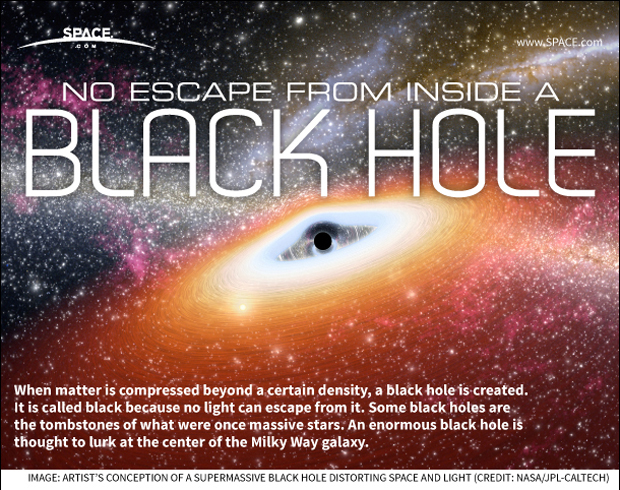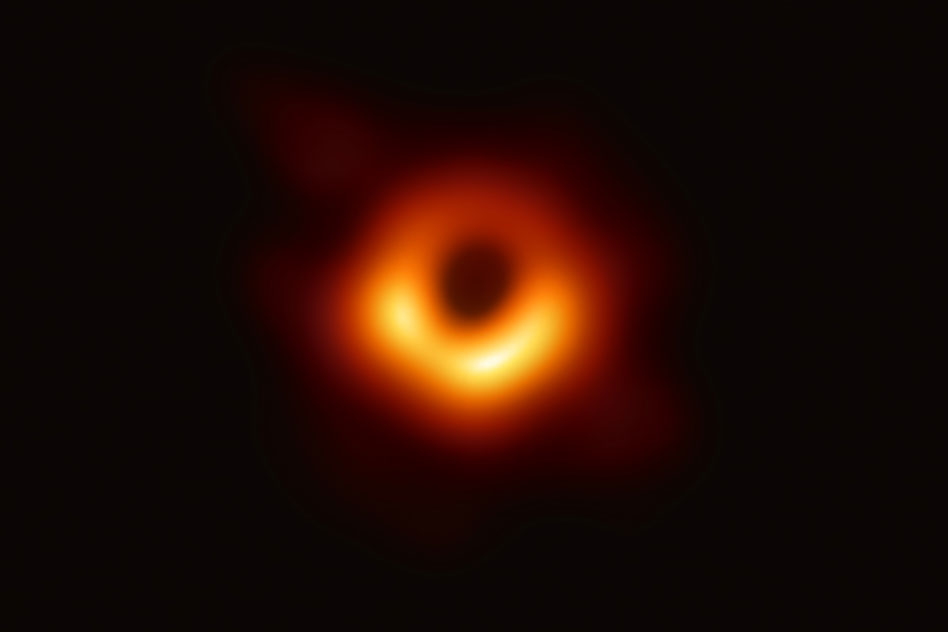Black holes are some of the strangest and most fascinating objects in outer space. They’re extremely dense, with such strong gravitational attraction that even light cannot escape their grasp if it comes near enough.
Albert Einstein first predicted the existence of black holes in 1916, with his general theory of relativity. The term “black hole” was coined many years later in 1967 by American astronomer John Wheeler. After decades of black holes being known only as theoretical objects, the first physical black hole ever discovered was spotted in 1971.
Then, in 2019 the Event Horizon Telescope (EHT) collaboration released the first image ever recorded of a black hole. The EHT saw the black hole in the center of galaxy M87 while the telescope was examining the event horizon, or the area past which nothing can escape from a black hole. The image maps the sudden loss of photons (particles of light). It also opens up a whole new area of research in black holes, now that astronomers know what a black hole looks like.
So far, astronomers have identified three types of black holes: stellar black holes, supermassive black holes and intermediate black holes.
Stellar black holes — small but deadly
When a star burns through the last of its fuel, the object may collapse, or fall into itself. For smaller stars (those up to about three times the sun’s mass), the new core will become a neutron star or a white dwarf. But when a larger star collapses, it continues to compress and creates a stellar black hole.
Black holes formed by the collapse of individual stars are relatively small, but incredibly dense. One of these objects packs more than three times the mass of the sun into the diameter of a city. This leads to a crazy amount of gravitational force pulling on objects around the object. Stellar black holes then consume the dust and gas from their surrounding galaxies, which keeps them growing in size.
According to a study by UV Irvine researchers on Forbes, the “Milky Way houses up to 100 million black holes.”
Supermassive black holes — the birth of giants
Small black holes populate the universe, but their cousins, supermassive black holes, dominate. These enormous black holes are millions or even billions of times as massive as the sun, but are about the same size in diameter. Such black holes are thought to lie at the center of pretty much every galaxy, including the Milky Way.
Scientists aren’t certain how such large black holes spawn. Once these giants have formed, they gather mass from the dust and gas around them, material that is plentiful in the center of galaxies, allowing them to grow to even more enormous sizes.
Supermassive black holes may be the result of hundreds or thousands of tiny black holes that merge together. Large gas clouds could also be responsible, collapsing together and rapidly accreting mass. A third option is the collapse of a stellar cluster, a group of stars all falling together. Fourth, supermassive black holes could arise from large clusters of dark matter. This is a substance that we can observe through its gravitational effect on other objects; however, we don’t know what dark matter is composed of because it does not emit light and cannot be directly observed.
Scientists once thought that black holes came in only small and large sizes, but recent research has revealed the possibility that midsize, or intermediate, black holes (IMBHs) could exist. Such bodies could form when stars in a cluster collide in a chain reaction. Several of these IMBHs forming in the same region could then eventually fall together in the center of a galaxy and create a supermassive black hole.
In 2014, astronomers found what appeared to be an intermediate-mass black hole in the arm of a spiral galaxy. And in 2021 astronomers took advantage of an ancient gamma-ray burst to detect one.
“Astronomers have been looking very hard for these medium-sized black holes,” study co-author Tim Roberts, of the University of Durham in the United Kingdom, said in a statement. “There have been hints that they exist, but IMBHs have been acting like a long-lost relative that isn’t interested in being found.”
Newer research, from 2018, suggested that these IMBHs may exist in the heart of dwarf galaxies (or very small galaxies). Observations of 10 such galaxies (five of which were previously unknown to science before this latest survey) revealed X-ray activity — common in black holes — suggesting the presence of black holes of from 36,000 to 316,000 solar masses. The information came from the Sloan Digital Sky Survey, which examines about 1 million galaxies and can detect the kind of light often observed coming from black holes that are picking up nearby debris.
What do black holes look like?

Black holes have three “layers”: the outer and inner event horizon, and the singularity.
The event horizon of a black hole is the boundary around the mouth of the black hole, past which light cannot escape. Once a particle crosses the event horizon, it cannot leave. Gravity is constant across the event horizon.
The inner region of a black hole, where the object’s mass lies, is known as its singularity, the single point in space-time where the mass of the black hole is concentrated.
Scientists can’t see black holes the way they can see stars and other objects in space. Instead, astronomers must rely on detecting the radiation black holes emit as dust and gas are drawn into the dense creatures. But supermassive black holes, lying in the center of a galaxy, may become shrouded by the thick dust and gas around them, which can block the telltale emissions.
Sometimes, as matter is drawn toward a black hole, it ricochets off the event horizon and is hurled outward, rather than being tugged into the maw. Bright jets of material traveling at near-relativistic speeds are created. Although the black hole remains unseen, these powerful jets can be viewed from great distances.
The Event Horizon Telescope’s image of a black hole in M87 (released in 2019) was an extraordinary effort, requiring two years of research even after the images were taken. That’s because the collaboration of telescopes, which stretches across many observatories worldwide, produces an astounding amount of data that is too large to transfer by internet.
With time, researchers expect to image other black holes and build up a repository of what the objects look like. The next target is likely Sagittarius A*, which is the black hole in the center of our own Milky Way galaxy. Sagittarius A* is intriguing because it is quieter than expected, which may be due to magnetic fields smothering its activity, a 2019 study reported. Another study that year showed that a cool gas halo surrounds Sagittarius A*, which gives unprecedented insight into what the environment around a black hole looks like.

Shining light on binary black holes
In 2015, astronomers using the Laser Interferometer Gravitational-Wave Observatory (LIGO) detected gravitational waves from merging stellar black holes.
“We have further confirmation of the existence of stellar-mass black holes that are larger than 20 solar masses — these are objects we didn’t know existed before LIGO detected them,” David Shoemaker, the spokesperson for the LIGO Scientific Collaboration (LSC), said in a statement. LIGO’s observations also provide insights about the direction a black hole spins. As two black holes spiral around one another, they can spin in the same direction or in the opposite direction.
There are two theories on how binary black holes form. The first suggests that the two black holes in a binary form at about the same time, from two stars that were born together and died explosively at about the same time. The companion stars would have had the same spin orientation as one another, so the two black holes left behind would as well.
Under the second model, black holes in a stellar cluster sink to the center of the cluster and pair up. These companions would have random spin orientations compared to one another. LIGO’s observations of companion black holes with different spin orientations provide stronger evidence for this formation theory.
“We’re starting to gather real statistics on binary black hole systems,” said LIGO scientist Keita Kawabe of Caltech, who is based at the LIGO Hanford Observatory. “That’s interesting because some models of black hole binary formation are somewhat favored over the others even now, and in the future, we can further narrow this down.”
Weird facts about black holes
- If you fell into a black hole, theory has long suggested that gravity would stretch you out like spaghetti, though your death would come before you reached the singularity. But a 2012 study published in the journal Nature suggested that quantum effects would cause the event horizon to act much like a wall of fire, which would instantly burn you to death.
- Black holes don’t suck. Suction is caused by pulling something into a vacuum, which the massive black hole definitely is not. Instead, objects fall into them just as they fall toward anything that exerts gravity, like the Earth.
- The first object considered to be a black hole is Cygnus X-1. Cygnus X-1 was the subject of a 1974 friendly wager between Stephen Hawking and fellow physicist Kip Thorne, with Hawking betting that the source was not a black hole. In 1990, Hawking conceded defeat.
- Miniature black holes may have formed immediately after the Big Bang. Rapidly expanding space may have squeezed some regions into tiny, dense black holes less massive than the sun.
- If a star passes too close to a black hole, the star can be torn apart.
- Astronomers estimate that the Milky Way has anywhere from 10 million to 1 billion stellar black holes, with masses roughly three times that of the sun.
- Black holes remain terrific fodder for science fiction books and movies. Check out the movie “Interstellar,” which relied heavily on Thorne to incorporate science. Thorne’s work with the movie’s special effects team led to scientists’ improved understanding of how distant stars might appear when seen near a fast-spinning black hole.
Additional resources:

